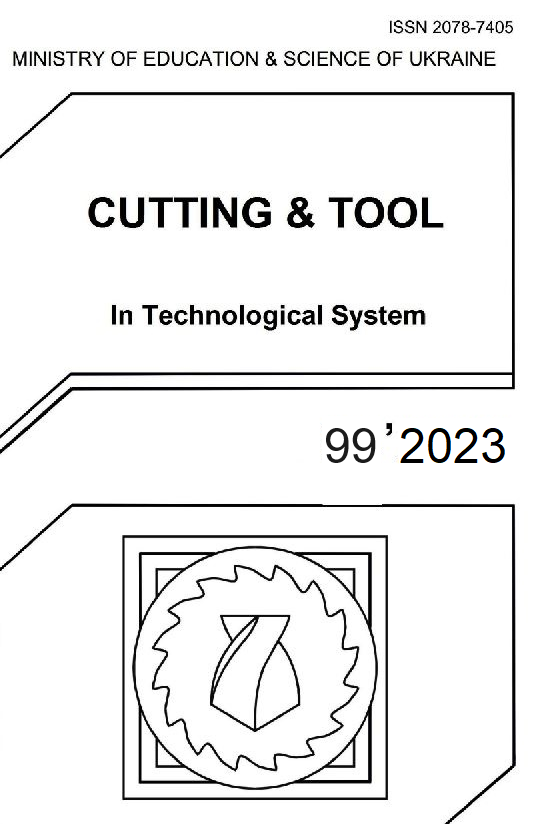ANALYTICAL ANALYSIS OF THE THEORETICAL SURFACE ROUGHNESS IN THE CASE OF BURNISHING OF CYLINDRICAL WORKPIECE
DOI:
https://doi.org/10.20998/2078-7405.2023.99.05Keywords:
mathematical model, modified Hertz theory, contact theory, problems of contact mechanicsAbstract
In the last decade, ensuring the highest possible surface quality of manufactured parts has been given a major priority, so more and more emphasis is being placed on the examination and development of finishing treatments that can effectively ensure increasingly stringent surface roughness. For this purpose, diamond burnishing - which is a widely used cold plastic technology - can be used productively as it can improve the surface roughness of the material. But even though due to the development of engineering technology, new possibilities and methods are constantly being developed to examine individual material structure changes, the ability to plan the surface roughness is very difficult. This paper focused on the determination of theoretical roughness to establish a mathematical model that can predict and analyse the relationship between experimental process parameters and surface roughness parameters. To validate the model, real experiments were performed, where the surface roughness were measured before and after the application of burnishing process on low alloyed aluminium shaft pieces.
References
P. Bernardos, G.C. Vosniakos: Prediction surface roughness in machining – review, International Journal of Machine Tools and Manufacture 43, pp. 833–844. 2003.
I. Sztankovics, J. Kundrak: Theoretical Value and Experimental Study of Arithmetic Mean Deviation in Rotational Turning, Rezanie i instrument v tehnologiceskikh sistemakh / Cutting and tool in technological systems, 96, pp. 73-81. 2022.
V. Molnar, I. Sztankovics: Analysis of Roughness Parameters Determining Tribological Properties in Hard Turned Surfaces, HUNGARIAN JOURNAL OF INDUSTRY AND CHEMISTRY 49, pp. 77–84. 2021.
J. Kundrak, A.P. Markopoulos, T. Makkai, N.E. Karkalos, A. Nagy: Multi-Objective Optimization Study in Face Milling of Steel, Proceedings of the International Symposium for Production Research pp. 3–15. 2018.
C. Felho, G. Varga: Theoretical roughness modelling of hard turned surfaces considering tool wear, Machines 10, .pp. 1–18. 2022.
I. Sztankovics, I. Pasztor: Preliminary Analysis of Surface Topography in Tangential Turning, Rezanie i instrument v tehnologiceskikh sistemakh/Cutting and tool in technological systems, 97, pp. 155–163. 2022.
M. Korzynski: Modelling and experimental validation of the force-surface roughness relation for smoothing burnishing with a spherical tool, International Journal of Machine Tools & Manufacture 47, pp.1956–1964. 2007.
P. Cui, Z. Liu, X. Yao, Y. Cai: Effect of Ball Burnishing Pressure on Surface Roughness by Low Plasticity Burnishing Inconel 718 Pre-Turned Surface, Materials 15, pp. 1–14. 2022.
R.O. Vaishya, V. Sharma, V. Mishra, A. Gupta, M. Dhanda, R.S. Walia, M. Kumar, A.D. Oza, D.D. Burduhos-Nergis, D.P. Burduhos-Negris: Mathematical Modelling and Experimental Validation of Surface Roughness in Ball Burnishing Process, Coatings 12, pp. 1–15. 2022.
C. Felho, G. Varga: CAD and FEM Modelling of Theoretical Roughness in Diamond Burnishing, International Journal of Precision Engineering and Manufacturing 23, pp. 375–384. 2022.
W. Bouzid, O. Tsoumarev, K. Sai: An Investigation of Surface Roughness of Burnished AISI 1042 steel, International Journal of Manufacturing Technology 24, pp. 120–125. 2004.
M. Korzynski: A Model of Smoothing Slide Ball-Burnishing and an Analysis of the Parameter Interaction, Journal of Materials Processing Technology 209, pp. 625–633. 2009.
C. Felho: Analytical Modelling of Theoretical Roughness for Some Typical Machining Process in the Mechanical Engineering Industry, Multidisciplinary Sciences 12, pp. 164–185 (in Hungarian). 2022.
S.D. Ponomarjov, V.L. Bidermann, K.K. Liharjev, V.M. Markusin, N.N. Malinyin, V.I. Feodoszjev: Strength Calculations in Mechanical Engineering 3, Technical Publisher Budapest, pp. 369–417 (in Hungarian). 1965.
C.E. Wu, K.H. Lin, J.Y. Juang: Hertzian Load-Displacement Relation Holds for Spherical Indentation on Soft Elastic Solids Undergoing Large Deformations, Tribology International 97, pp. 71–76 2006.
Z. Guo, M. Hao, L. Jiang, D. Li, Y. Chen, L. Dong: A Modified Hertz Model for Finite Spherical Indentation Inspired by Numerical Simulations, European Journal of Mechanics/A Solids 83, pp. 1–13. 2020.
K. Han, D. Zhang, C. Yao, L. Tan, Z. Zhou, Y. Zhao: Analytical Modelling of Through Depth Strain Induced by Deep Rolling, Journal of Strain Analysis 00, pp. 1–12. 2021.
M.R. Stalin John, A. Welsoon Wilson, A. Prasad Bhardwaj, A. Abraham, B.K. Vinayagam: An investigation of ball burnishing process on CNC lathe using finite element analysis, Simulation Modelling Practice and Theory 62, pp. 88–101. 2016.
Downloads
Published
Issue
Section
License
Copyright Notice
Authors who publish with this Collection agree to the following terms:
1. Authors retain copyright and grant the Collection right of first publication with the work simultaneously licensed under a Creative Commons Attribution License that allows others to share the work with an acknowledgement of the work's authorship and initial publication in this Collection.
2. Authors are able to enter into separate, additional contractual arrangements for the non-exclusive distribution of the Collection's published version of the work (e.g., post it to an institutional repository or publish it in a book), with an acknowledgement of its initial publication in this Collection.
3. Authors are permitted and encouraged to post their work online (e.g., in institutional repositories or on their website) prior to and during the submission process, as it can lead to productive exchanges, as well as earlier and greater citation of published work.

